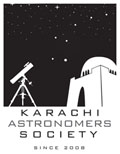The second lunar eclipse of 1432AH and the first of 2011 will be the darkest eclipse in 22 years. If you have never seen the summer Milky Way at its prime, you now have two very strong excuses for travelling to a dark sky site to observe this total lunar eclipse and the galactic center high in the sky.

The summer Milky Way (unprocessed shot by Hanif Bhatti from Hingol, Balochistan)

What the Moon normally does to the Milky Way (Shot by Zagham Islam from Baltistan, Pakistan)
The eclipse occurs on 15th/16th June when the Moon is at the ascending node in southern Ophiuchus, about 7° west of the Lagoon Nebula (M8). Perhaps you know that the Lagoon Nebula is an obvious naked-eye target from dark skies. The Moon plunges deep into Earth’s umbral shadow during this rather long event, with totality itself lasting 100 minutes. The last eclipse to exceed this duration was that of July 2000. Fred Espenak, “Mr. Eclipse” of NASA, reflecting about a total lunar eclipse he witnessed in the same part of the sky nearly three decades ago writes, “I was amazed at how brilliantly the summer Milky Way glowed since it was all but invisible during the partial phases.”
The Moon’s contact times with Earth’s umbral and penumbral shadows in Pakistan Standard Time (PKT) are listed below:
15TH June 2011 (Wednesday)
Penumbral Eclipse Begins: 22:24:34 PKT
Partial Eclipse Begins: 23:22:56 PKT
16TH June 2011 (Thursday)
Total Eclipse Begins: 00:22:30 PKT
Greatest Eclipse: 01:12:37 PKT
Total Eclipse Ends: 02:02:42 PKT
Partial Eclipse Ends: 03:02:15 PKT
Penumbral Eclipse Ends: 04:00:45 PKT

Things to Do During the Eclipse
For City Dwellers
The next day is Thursday – a working day – so likely the best thing you can do is catch up on sleep so that you do not run late for office or uni the following morning. After all, you can hopefully see some stunning shots of the eclipse on the internet the next day. But if your electric utility company is bent upon making you observe the eclipse, go outdoors or upstairs at around 1am and have a look. If the sky is free of clouds, may be you can shoot the blood red Moon with some interesting object in the foreground. Before you retire to bed, do try to offer two rakat of Salat-ul-Qusoof. After that, well, I wish you sweet dreams!
For Adventurers and Photographers
If the sky is clear and you are like me, pack some seekh kebabs, dessert and soft drinks and head out to a dark sky site. With any luck, you may find a suitably dark location less than 100km from your home. But since this eclipse is Insha Allah going to be a rare opportunity to see and shoot the Moon at the same time as the Milky Way, the darker the skies you can find, the better. Don’t forget to take Mospel along, even if you don’t need it there.
Once it gets dark, light up a bonfire – no need to worry about your dark adaption yet – have a live barbeque and chill out. The bright moonlight will provide excellent opportunities for shooting some scenic nightscapes. If you are very lucky, you may even capture a meteor on one of your shots. Put the fire out by 10pm. You may then either set an alarm for 11:15pm and have a nap or kill time by sharing horror stories (yup, been there, done that). Sorry, no political discussions please. Once the eclipse starts to slowly unfold, you can shoot nightscapes, make a time-lapse video, sketch or simply watch. When the eclipse is near maximum, try to pray a few rakat Salat-ul-Qusoof.
The Technicalities
Here is the visibility map of the lunar eclipse: link. At greatest eclipse the umbral eclipse magnitude will drop to 1.6998 as the Moon’s centre passes within 5.3 arc-minutes of the shadow axis. The southern limb of the Moon will be 54.2 arc-minutes from the edge of the umbra while the northern limb will be 22.3 arc-minutes from the umbra’s edge. Thus, the northern regions of the Moon will probably appear brighter than the southern regions that lie deeper in the shadow. Since the Moon samples a large range of umbral depths during totality, its appearance will change dramatically with time. It is difficult to predict the exact brightness distribution in the umbra so observers are encouraged to estimate the Danjon value at different times as totality progresses. Note that it may also be necessary to assign different Danjon values to different portions of the Moon (i.e. north vs. south). Check out this link about the Danjon scale of lunar eclipse brightness.
Clear skies and happy gazing!
Written by:
Zain Ahmed
Update 17th June 2011: The KaAS team was about 25km north of Bela in Balucistan for the eclipse. We saw quite a spectacle with binoculars but could not take good photos because the transparency was not good.
A stacked image of 7 single 30s shots taken with a Canon EOS 5D Mark II modified camera and a 85mm Carl Zeiss Plannar 85 @ f/4.5 and ISO 2000 by Amir H. Abolfath from Firuzkuh, Iran. This is not a composite or multiple exposure.



